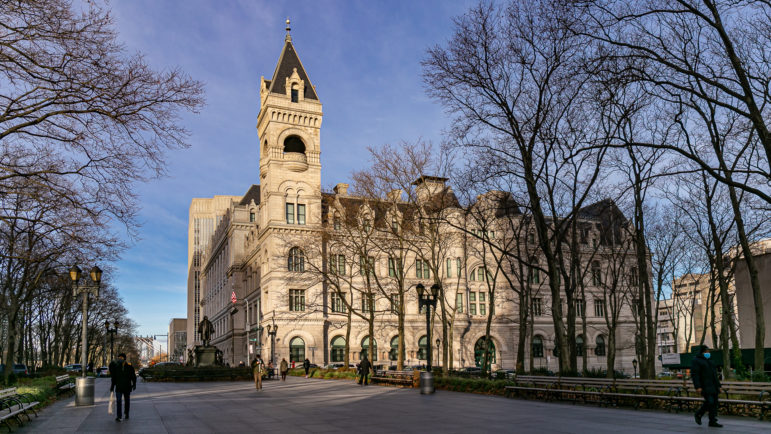Filings are down by nearly 50 percent this year thanks to debt forbearance, federal aid, slower courthouses and the persistent stigmas against declaring a personal financial crisis.

Adi Talwar
The Bankruptcy Court for the Eastern District of New York in Brooklyn.Amid the gravest economic crisis in memory, bankruptcy filings have plummeted in the New York City area, reflecting a counterintuitive national trend that could portend a harsh period of reckoning some time in 2021.
There were 21,005 filings from March through mid-December 2019 for personal and business bankruptcy in the federal Southern District (New York, Bronx, Westchester, Rockland, Putnam, Orange, Dutchess, and Sullivan counties) and Eastern District (Kings, Nassau, Queens, Richmond, and Suffolk counties). Over the same period this year, there were 11,006 filings—a decrease of 48 percent.
The drop was steepest in the Eastern District, where filings are off by 59 percent. They are off by 27 percent in the Southern District.
That mirrors the national picture: According to statistics from Epiq Systems reported by the American Bankruptcy Institute, bankruptcy filings are down 30 percent nationwide this year. Only one state, Delaware, has seen filings rise. Louisiana has seen the steepest drop: 42 percent. Statewide, New York has seen a 41 percent decease, the fifth steepest nationwide.
The slowdown might be coming an end. Bankruptcy counselors say they are starting to see an increase in people seeking help in filing for protection from creditors. More are expected soon, as demands for payment grow more intense.
Bankruptcy Filings, SDNY & EDNY
| Month | CY2019 | CY2020 | Change 2019-2020 |
| March | 2,346 | 1,581 | -32.6% |
| April | 2,390 | 1,023 | -57.2% |
| May | 2,484 | 915 | -63.2% |
| June | 2,203 | 1,196 | -45.7% |
| July | 2,072 | 1,096 | -47.1% |
| August | 1,914 | 1,140 | -40.4% |
| September | 2,122 | 1,113 | -47.5% |
| October | 2,196 | 1,593 | -27.5% |
| November | 2,325 | 875 | -62.4% |
| December (through 12/15) | 953 | 474 | -50.3% |
| TOTAL | 21,005 | 11,006 | -47.6% |
“Debt collection efforts were on pause for quite some time,” Sidney Cherubin, the director of legal services at the Brooklyn Bar Association Volunteer Lawyers Project, tells City Limits via email. “We are now starting to see more debt collection efforts and this I think will make debtors start thinking about bankruptcy again.”
The dearth of debt collection lawsuits in recent months might have reflected decisions by collectors to grant a grace period in light of widespread economic dislocation. Or it could just mean that closed courthouses and other pandemic restrictions made it hard to file cases. “I think it has to do with the difficulty in doing anything in this context,” says Bill Kransdorf, director of New York City Bankruptcy Assistance Project at Legal Services NYC. He expects debt collectors are “waiting to file until it’s easier to file suits and get judgements.” It’s rare for people to file for bankruptcy who aren’t facing a debt-collection suit, he says.
It’s also harder these days for debtors to get bankruptcy cases going—even just to get documents to the lawyers who might prepare their petitions, Cherubin writes. “This difficulty has truly slowed the process—trying to figure out how to go over the petition with the debtor and getting signatures on the petition,” he adds.
What’s more, “Unrepresented litigants may have just been afraid to venture out during the pandemic and go into the courthouse to file petitions,” Cherubin says.
It’s also likely that government aid equipped people to avoid a debt crisis. “There were relief measures put into place like the New York State eviction moratorium,” says Ramona Morel, director of the consumer bankruptcy project at the City Bar Justice Center. “There were definitely protections and benefits in the CARES Act.” Some of Kransdorf’s clients made more from the pandemic unemployment aid than they had in their jobs.
The extra money might not have materially changed their economic situation, but it could have kept the wolves at bay. People do not typically seek bankruptcy protection unless they are truly desperate. “Bankruptcy is a useful tool. It provides business and individuals with a fresh start. But it still has a stigma,” says Morel. “Bankruptcy is used as a last resort.”
With extra federal unemployment aid running out, that calculation could change in the months ahead. Filings could be driven by business failures and medical costs—people who have delayed treatment for non-COVID issues and might face more serious consequences and higher bills now. Oddly enough, an improving economy could also trigger problems: Borrowers and lenders might have acted with caution when the economy was in the tank, Kransdorf says, but as conditions approve, new debts will be created, creating the potential for new bankruptcies.
The legislative landscape could also change. A measure introduced earlier this month by Massachusetts Sen. Elizabeth Warren and New York Rep. Jerrold Nadler, the Consumer Bankruptcy Reform Act, would make it easier for low- and moderate-income households to apply for bankruptcy. It is possible Congress will act on the bill next year.








